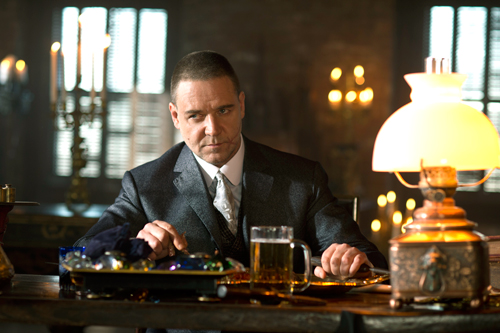Based off the book of the same name, the new film “Winter’s Tale” tries to put a spin on the typical whirlwind romance by including demons in derby hats, angels with a debt to pay and a flying horse. Though the story itself showed potential, so much of the book’s plot was glossed over that many things lost their true meaning. “Winter’s Tale” is a tale that should be left to the written word.
Set in two time periods, 1916 and present day, the supernatural story follows orphaned thief Peter Lake (Colin Farrell, “In Bruges”) as he tries to escape from previous boss Pearly Soames (Russell Crowe, “Gladiator,”), who is a demon taking human form. In the midst of one of Lake’s robberies, he comes across Beverly Penn (Jessica Brown Findlay, “Downton Abbey”), the daughter of the house owner. The two quickly fall in love as Soames closes in on Lake. Yet Penn is slowly dying of consumption, with only Lake’s love to save her from impending death.
The plot is extremely dense, using a variety of religious imagery and characters such as Will Smith’s Lucifer (“Men in Black”) and a continued metaphor of stars being people’s souls. In the film, every single soul has the ability to cause one miracle—a single extraordinary event that becomes one’s reason for living. It seems that Lake’s miracle will be saving Penn, but all is not as it appears. The plot becomes even less understandable when Soames nearly kills Lake, making him lose his memories. He spends over 90 years wandering Manhattan, never aging and never remembering anything, until he is introduced to a reporter who helps him reclaim his past.
The over-the-top romance storyline throughout “Winter’s Tale” is to be expected over the weekend of Valentine’s Day, so those looking for an intellectual or action movie will not be impressed. Lake and Penn’s romance is straight out of 20th-century Disney films, with Lake proclaiming his endless love a mere 24 hours after their meeting. Such fantasy fits well with the supernatural tone of the film. Because the romance is presented on screen in a mere two hours, it is harder to comprehend than words spread out over hundreds of pages.
The actors and actresses in the film are all very well known, from Smith to Farrell to Jennifer Connelly as Virginia Gamely (“A Beautiful Mind”), the reporter who helps Lake rediscover himself. The all-star cast does manage to salvage some aspects of the film, but the complex and unexplained plot are not stitched back together through good acting. Farrell does a good enough job as the phenomenally uncomplex Lake, while Smith brings his acting skills to the forefront as a calm, meditative Lucifer. Neither Connelly nor Findlay can do much with their female characters as they remain mostly undeveloped and as mere means to an end for the men in the film.
One very interesting aspect of the film is its use of light and the cinematography used to enhance it. With the continued metaphor of stars as souls, there are repeated night shots that include lens flares. These flares are used throughout the film as a continuous device, such as the scene when Penn explains how the consumption affects her vision, brightening all light that she can see, making it almost painful for viewers to look at the screen.
While “Winter’s Tale” may be captivating on paper, it does not work as well on the silver screen. The acting is proficient enough to keep the audience’s attention, in addition to the plot, though it is complex and underdeveloped. For romantics, this film will hold appeal, but supernatural fans looking for an interesting alternative world will be unimpressed as the fantasy is not as fleshed out as the romance.











